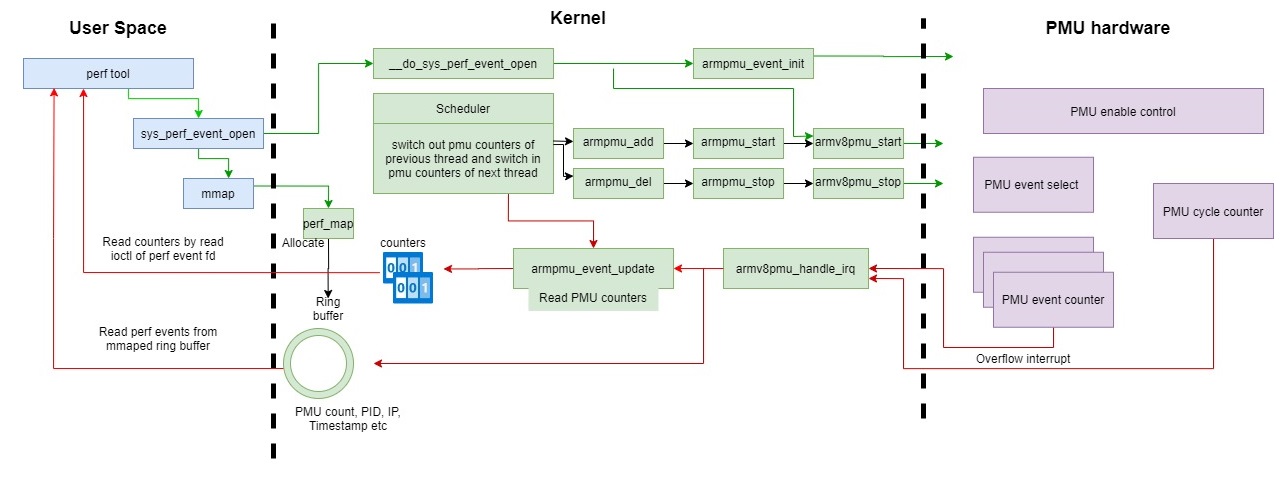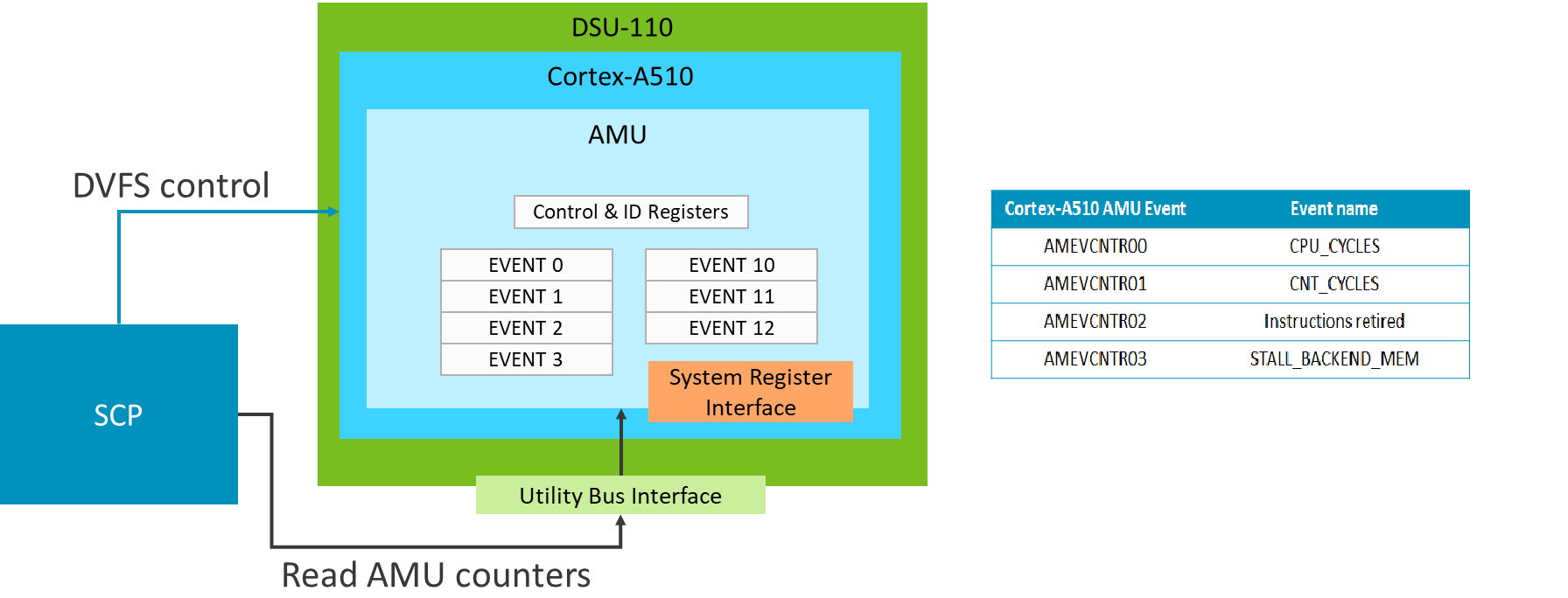一篇我写的文章:What is the difference between AMU and PMU?https://developer.arm.com/doc...
A-Prolifile构架中的Performance Monitoring Unit(PMU)和Activity Monitoring Unit(AMU)都具有性能计数器。AMU和PMU可以计数的事件类似,那么AMU和PMU有什么不同呢?
AMU和PMU的区别在于:
- AMU和PMU用作不同用途
- AMU和PMU有不同的编程模式
不同的用途
PMU的用途是性能分析和调试。PMU提供了一序列的事件计数,如cache miss, TLB miss,CPU cycle,已经执行的指令数,用来做性能分析和调试。PMU可以被如Linux perf tool, arm DS-5/arm DS等性能分析工具利用。
虽然构架上定义了一系列的通用事件,每个CPU实现可以定义它特用的事件。可以参考Arm Architecture Reference Manual Armv8, for Armv8-A architecture profile和CPU处理器手册的PMU事件和事件号码章节获得更多PMU事件的信息。
AMU的用途是系统管理和监控,特别是功耗和性能管理。例如,可以使用AMU计数器作为CPU处理器活跃度信息来帮助DVFS的调节。
AMU提供了少数的简单,固定的,free-running的计数器。AMUv1包括下列事件计数器:
• 4个构架规定的64-bit事件计数器
- CPU cycle计数器,它以CPU的频率递增
- 常量计数器,它以system counter的固定频率递增
- 退役指令(Instructions retired), 它计数每条构架意义上执行过的指令(non speculative)
- 内存暂停周期数(Memory stall cycles),它计数由于在同一clock domain中的最后一级cache中miss导致的指令分发暂停周期数(instruction dispatch stall cycles)
• 多至16个的附加64-bit事件计数器
这些计数器计数一个附加的事件。取决于CPU处理器的实现,计数的事件可以是固定的,或是可编程的。
Cortex-A510的例子:
不同的编程模式
相较于PMU,AMU缩减了功能集,并降低了事件选择的自由度。
以下表格比较了PMU和AMU支持的功能
| Functionality | PMU | AMU | Comment |
|---|---|---|---|
| Filtering by exception level | Yes | No | - |
| Processor frequency cycle counter | Yes | Yes | Allocated to an architected event counter |
| Event Counter Selection Register | Yes | No | The PMU uses the PMSELR_EL0 register to select the current event counter for event type configuration and reading count value. The AMU does not need to select event counters. Each counter has dedicated control in AMU registers |
| Counter Enable/Disable | Yes | Yes | The PMU needs software to select the counter in PMSELR first for the counter Enable/Disable, while each AMU counter can be individually enabled and disabled |
| Event type | Yes | Yes | If AMU hardware implementation supports programmable auxiliary event, it selects which event to monitor. If AMU hardware implementation supports fixed events, it selects the fixed events. |
| Counter overflow and interrupt | Yes | No | - |
| Software increment | Yes | No | - |
PMU的编程
软件通过以下步骤来编程PMU事件计数器
- 在Performance Monitors Control Register (PMCR)中使能PMU
- 配置一个事件计数器
- 将你想使用的事件计数器号码设置到Performance Monitors Event Counter Selection Register (PMSELR) PMSELR.SEL bit
- 将你想计数的事件的号码设置到Performance Monitors Event Type Select Register (PMXEVTYPER) PMXEVTYPER.evtCount, 来设置上面的事件计数器观测的事件
3.在Performance Monitors Count Enable Set Register (PMCNTENSET)中使能配置好的事件计数器
AMU的编程
相较于PMU,AMU因为有更少的事件而具有更简单的编程模式。
计数构架定义事件的计数器是固定的,因而event type registers, AMEVTYPER0<n>_EL0是只读的。
附加的64-bit事件计数器是通过AMEVCNTR1<n>_EL0来访问的。每个计数器计数那种事件,这些事件是固定的还是可以通过event type registers编程的由CPU硬件实现决定。因而AMEVTYPER1<n>_EL0可能是只读的或是可读写的。
AMU不采用PMU PMSELR寄存器选择要观测事件的方式。
采用以下方式编程一个AMU事件计数器:
- 使能和禁止计数器
- 每个计数器可以单独使能或禁止
- 构架定义的计数器通过设置AMCNTENSET0_EL0相应bit使能,通过设置AMCNTENCLR0_EL0相应bit禁止
- 附加计数器的使能和禁止通过设置AMCNTENSET1_EL0和AMCNTENCLR1_EL0相应bit实现
- 读计数器值
- 构架定义事件计数器的计数器值通过读相应的AMEVCNTR0<n>_EL0获取,而附加事件计数器的计数器值通过读相应的AMEVCNTR1<n>_EL0寄存器获取





